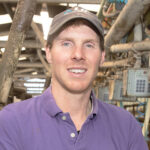Farmer Focus: Rain allows leatherjackets to flare up
 © Tim Scrivener
© Tim Scrivener It’s been “all hands on deck” over the past couple of weeks. Spring cropping and maintaining grass intakes in wet conditions have kept us occupied.
We have also been busy preparing to host the Leicestershire and Rutland Young Farmers annual county rally at the farm.
To add to the mayhem, we are reconcreting the main yard, which has created a few logistical issues, particularly with silage making and slurry carting occurring at the same time.
See also: Limit leatherjacket damage with good autumn planning
Concreting the main artery of the farm is the easy bit, it’s the drainage and services below that take time and thought, to future-proof the yard for any changes that may come.
After a week of rain and last minute efforts to find a dry paddock to park everyone, the day of the YFC visit finally came around.
It was great to see the strength of the federation still going strong and the social, practical and organisational skills it coaches to all members. Thank you to local businesses, small and large, who supported the rally.
We had more than 1,000 people in attendance for the event. To celebrate each club’s achievements there is an evening do, which saw more than 600 people partying the night away.
Spring cropping hasn’t been made easy this year. It’s been a challenge trying to find a dry window to drill and, furthermore, leatherjackets have destroyed a substantial area of fodder beet and forage wholecrops.
Normally, rolling would suppress the leatherjacket damage, but the wet weather got in the way, so we couldn’t roll.
Rotation is key in an organic system for soil health and weed control, so we will grow beet and wholecrops after lucerne and long-term grass leys.
To reduce the impact for next season, we will aim to plough-in the cover crops in six weeks prior to drilling.
To end on a positive note, after the final pregnancy diagnosis session for autumn breeding, we achieved a 74% six-week in-calf rate and 8% empty rate on the cows, and 7.5% for the heifers.
This will make a busy start to calving, with 357 in the first three weeks.

